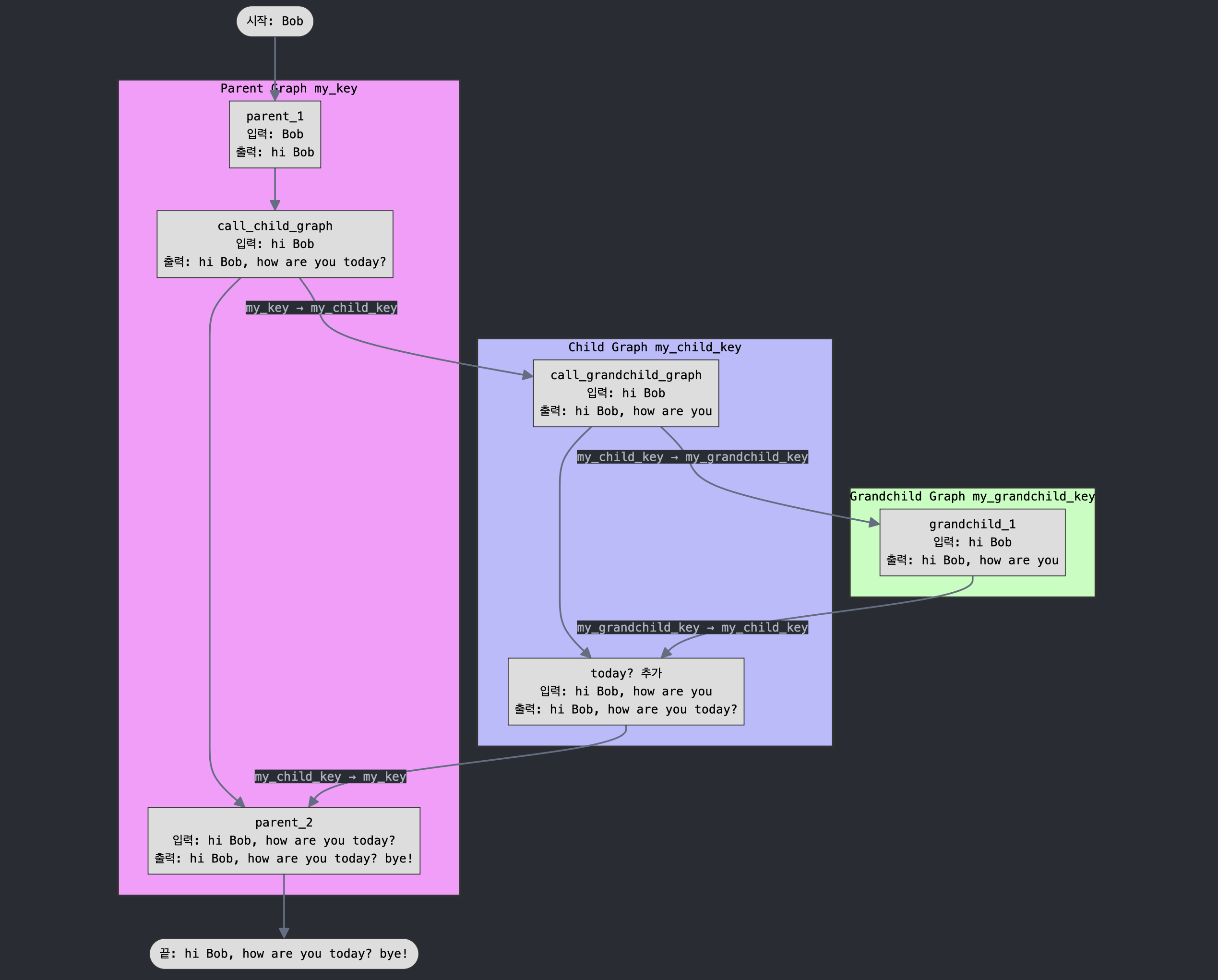langgraph - sub-graph - 서로 다른 Schema를 갖는 Graph는 어떻게 그 연결을 통제할까?
State 변환: LangGraph 부모-자식 Graph 간 스키마 불일치 해소
LangGraph를 사용하여 복잡한 에이전트 워크플로우를 설계할 때, 상위(parent) 그래프와 하위(subgraph) 그래프 간에 서로 다른 state 스키마를 사용해야 하는 경우가 자주 발생합니다. 이 글에서는 세 단계의 계층 구조를 가진 그래프들이 어떻게 서로 다른 state를 주고받는지 설명합니다.
한가지 예시를 들어보겠습니다. 아래와 같은 구조를 갖는 예시를 통해 각기 서로 다른 스키마를 갖는 3개의 계층적 그래프(parent <> child <> grand-child)
서로 다른 스키마의 Graph가 하나의 Flow로 연결되기까지
각 그래프는 독립적인 state key를 가지고 있으며, 계층 간 통신을 위해서는 state 변환이 필요합니다.
- 스키마 - Parent Graph:
my_key - 스키마 - Child Graph:
my_child_key - 스키마 - Grandchild Graph:
my_grandchild_key
위처럼 서로 다른 스키마를 갖는 Graph가 계층적(부모-자식-자손) 구조 속에서 스키마를 바꿔가며 value update를 거쳐 최종 output을 생성하게 됩니다.
1
"Bob" → "hi Bob" → "hi Bob, how are you" → "hi Bob, how are you today?" → "hi Bob, how are you today? bye!"
LangGraph의 State Key 제약사항
LangGraph는 그래프 간 state channel(key)이 일치해야만 바로 연결할 수 있도록 기본 설계되어 있습니다. 이는 서로 다른 key를 사용하는 그래프들을 직접 연결할 수 없다는 것을 의미합니다. 이 제약을 해결하기 위해서는 두 그래프를 연결하기 전에 “state 변환 함수”를 두어 각 그래프가 요구하는 state key 형태에 맞게 변환해야 합니다.
이제 각 계층의 구현 방법을 자세히 살펴보겠습니다.
Step 1: Grandchild Subgraph 정의
가장 먼저 최하위 그래프인 Grandchild Subgraph를 정의합니다. 이 그래프는 GrandChildState라는 TypedDict로 상태 스키마를 정의하고, my_grandchild_key라는 key 하나만 관리합니다.
1
2
3
4
5
6
7
8
9
10
11
12
13
14
15
16
17
from typing_extensions import TypedDict
from langgraph.graph.state import StateGraph, START, END
class GrandChildState(TypedDict):
my_grandchild_key: str
def grandchild_1(state: GrandChildState) -> GrandChildState:
# grandchild_1 노드는 문자열 끝에 ", how are you"를 추가합니다
return {
"my_grandchild_key": state["my_grandchild_key"] + ", how are you"
}
grandchild = StateGraph(GrandChildState)
grandchild.add_node("grandchild_1", grandchild_1)
grandchild.add_edge(START, "grandchild_1")
grandchild.add_edge("grandchild_1", END)
grandchild_graph = grandchild.compile()
실행해보면 다음과 같은 결과를 얻을 수 있습니다:
1
2
3
output = grandchild_graph.invoke({"my_grandchild_key": "Hi Bob"})
print(output)
# {'my_grandchild_key': 'Hi Bob, how are you'}
Step 2: Child Subgraph 정의
Child Subgraph는 중간 계층으로, ChildState라는 독립적인 스키마를 사용합니다. 이 그래프는 my_child_key라는 key를 관리하며, Grandchild와의 통신을 위해 state 변환이 필요합니다.
1
2
3
4
5
6
7
8
9
10
11
12
13
14
15
16
17
18
19
20
21
22
23
24
25
26
class ChildState(TypedDict):
my_child_key: str
def call_grandchild_graph(state: ChildState) -> ChildState:
"""
Child와 Grandchild 간의 state 변환을 담당하는 함수입니다.
1) ChildState -> GrandChildState 변환 (입력)
2) Grandchild 호출
3) GrandChildState -> ChildState 변환 (출력)
"""
# 1) ChildState -> GrandChildState로 변환
grandchild_graph_input = {"my_grandchild_key": state["my_child_key"]}
# 2) Grandchild 그래프 호출
grandchild_graph_output = grandchild_graph.invoke(grandchild_graph_input)
# 3) GrandChildState -> ChildState로 다시 변환하고 "today?"를 추가
return {
"my_child_key": grandchild_graph_output["my_grandchild_key"] + " today?"
}
child = StateGraph(ChildState)
child.add_node("child_1", call_grandchild_graph)
child.add_edge(START, "child_1")
child.add_edge("child_1", END)
child_graph = child.compile()
Child Subgraph를 실행해보면:
1
2
3
output = child_graph.invoke({"my_child_key": "Hi Bob"})
print(output)
# {'my_child_key': 'Hi Bob, how are you today?'}
Step 3: Parent Graph 정의
마지막으로 최상위 그래프인 Parent Graph를 정의합니다. 이 그래프는 ParentState를 사용하며, my_key라는 key로 상태를 관리합니다.
1
2
3
4
5
6
7
8
9
10
11
12
13
14
15
16
17
18
19
20
21
22
23
24
25
26
27
28
29
30
31
32
33
34
35
36
37
38
class ParentState(TypedDict):
my_key: str
def parent_1(state: ParentState) -> ParentState:
# 문자열 앞에 "hi "를 추가
return {"my_key": "hi " + state["my_key"]}
def parent_2(state: ParentState) -> ParentState:
# 문자열 끝에 " bye!"를 추가
return {"my_key": state["my_key"] + " bye!"}
def call_child_graph(state: ParentState) -> ParentState:
"""
Parent와 Child 간의 state 변환을 담당하는 함수입니다.
1) ParentState -> ChildState 변환 (입력)
2) Child Subgraph 호출
3) ChildState -> ParentState 변환 (출력)
"""
# 1) ParentState -> ChildState로 변환
child_graph_input = {"my_child_key": state["my_key"]}
# 2) Child 그래프 호출 (내부적으로 Grandchild도 호출됨)
child_graph_output = child_graph.invoke(child_graph_input)
# 3) ChildState -> ParentState로 다시 변환
return {"my_key": child_graph_output["my_child_key"]}
parent = StateGraph(ParentState)
parent.add_node("parent_1", parent_1)
parent.add_node("child", call_child_graph)
parent.add_node("parent_2", parent_2)
parent.add_edge(START, "parent_1")
parent.add_edge("parent_1", "child")
parent.add_edge("child", "parent_2")
parent.add_edge("parent_2", END)
parent_graph = parent.compile()
전체 워크플로우를 실행해보면:
1
2
3
result = parent_graph.invoke({"my_key": "Bob"})
print(result)
# {'my_key': 'hi Bob, how are you today? bye!'}
